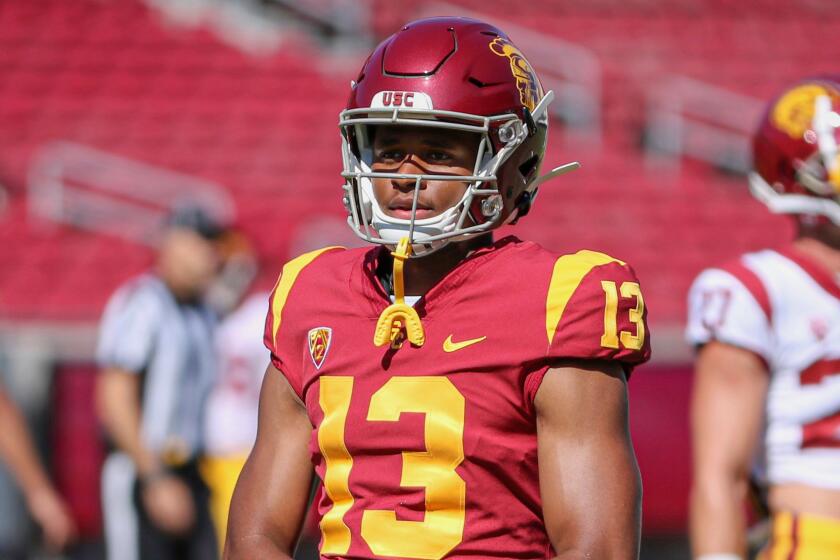USC is going Hollywood to help its athletes promote their brand
- Share via
Outside TCL Chinese Theatre, in the heart of Hollywood, cameras flash in a continuous stream as social media influencers dressed in gowns stroll along a red carpet. Curious tourists in masks gather along the edge of the Hollywood Walk of Fame, scanning the scene for celebrities. Soon, a helicopter will fly overhead, filming from above.
At the edge of the red carpet, Kedon Slovis, dressed in suit and tie, is trying to figure out his place in the picture. Slovis is not easily fazed, but strutting down a red carpet, even if it is just for an in-house video, is a bit outside the USC quarterback’s comfort zone.
A suited-up Clay Helton and his USC staff would probably say the same. Though cornerbacks coach Donte Williams, bouncing around in bold red loafers, seems right at home.
It’s not a scene usually expected from a university athletic department. But that’s precisely the reason for this ambitious undertaking by USC to announce the launch of BLVD Studios, its new in-house creative lab for branding and player-driven content for all its athletes. They’re determined to go big.
With landscape-altering changes ahead for college athletics when the NCAA Division I Council decides next year on new rules for name, image and likeness (NIL), USC is hoping to get ahead of its West Coast competition, to harness the allure of Hollywood, and to establish itself as a branding powerhouse in what department officials have repeatedly referred to as “the media capital of college football.”
Hence, the oh-so-Hollywood setup for the announcement video — the red carpet, the influencers, and even a Heisman Trophy winner hanging with the statue and a film crew inside. Everyone involved was tested and cleared beforehand.
Few quarterbacks were more famous than Matt Leinart in his USC heyday. Amid a new landscape with NIL, USC’s plan is to sell top recruits on a new age of full-service brand-building that goes beyond Leinart levels, complete with social content creation, data-driven brand research, personal logos and podcasts.
“Where it seems like college athletics is going, where it’s about the players, it’s about their branding opportunities, it’s about providing them chances to cash in,” said Spencer Harris, USC’s director of player personnel.
That starts with a partnership with J1S, a full-service creative agency that has also worked with the likes of Oklahoma and Georgia Tech. USC will be the agency’s only client in the West, and Mike Jones, the founder of J1S, acknowledged that the university already had major, inherent advantages that most markets didn’t.
USC hopes to have the creative infrastructure to exploit those advantages on the recruiting trail, while other schools adjust to the new world of NIL.
The protocols to decide USC sophomore wide receiver Munir McClain’s fate are still unclear as NCAA rules do not cover unemployment benefits.
“There’s very few opportunities in which you’ll see a mass shift of an entire market,” Jones said. “In those opportunities, it’s the brands that capitalized right when that takes place that will catapult themselves to the top again.”
Helton agrees. The head coach hears recruits talk routinely about their personal branding, and USC has already offered top prospects detailed presentations on name, image and likeness. Often, Helton and his staff point to Juju Smith-Schuster, the former USC and current Pittsburgh Steelers wideout whose massive social media presence includes over 1 million YouTube subscribers. It’s no coincidence the receiver made an appearance in one of Thursday’s launch videos.
“I truly believe student athletes are going to be looking at their development as a marketable commodity,” Helton said. “I think schools can either be proactive or reactive, and we wanted to be proactive.”
USC had already sought to rebuild the foundation of its branding and social media operation over the past year, hiring a graphic designer, Alex Verdugo, away from Oregon, and a video producer, Will Stout, from Louisiana State. In January, it struck a partnership with INFLCR to bolster branding efforts even further.
The introduction of BLVD Studios is the culmination of those efforts, complete with helicopter fly-overs and a filmed mansion pool party in the Hollywood Hills. It’s the exact sort of image of Los Angeles that USC hopes to conjure for recruits eager to build their brands.
Those are the type of players that Harris says will be “a really good fit” for USC in the new NIL era. But the flashy videos are only a part of the pitch for recruits looking to capitalize. They also plan to educate them on how best to use that exposure.
“We can analyze and pull data based on who their followers are, what their engagement is like, and provide them that information,” Harris said. “We can show them what their peers are potentially doing better than they are, where they can go, what areas they can grow their social media channels. … The education, the data at their fingertips to build their brands, and then the way we’ll display them to the millions in Los Angeles and college football, it’s putting their brands out there more than anyone else can in the country.”
That pitch will become increasingly more common at the collegiate level in the coming months, when new NIL rules become a reality. But even with the backdrop of Los Angeles and the built-in advantages that come with it, USC hopes its own in-house creative agency will help separate the program from others pitching recruits on their potential branding power.
“We don’t want to just rely on USC, the brand,” Harris said. “We can’t. We want to use USC, the brand, to push us forward, to be innovative, to push the envelope.”
More to Read
Go beyond the scoreboard
Get the latest on L.A.'s teams in the daily Sports Report newsletter.
You may occasionally receive promotional content from the Los Angeles Times.








